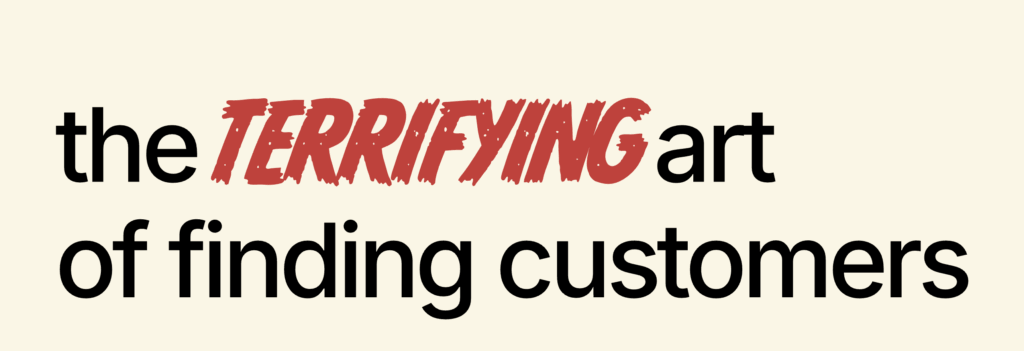The Challenge of Authentic Selling with Kunick Kapadia

You don’t “arrive” at product-market fit. You earn it, keep it, and re-earn it.
This post distills the most useful, no-nonsense lessons from a conversation on the Predictable Revenue Podcast with Collin Stewart and Anova’s co-founder, Kunick Kapadia, focusing squarely on what you can use now.
We cut through the noise: validate before you build, treat PMF as a sliding scale, and own the first $1M in sales because that’s where the product learns. Pricing is a test, not a guess. Imposter syndrome is normal. Evidence beats anxiety. And in crowded markets, differentiation wins; AI can amplify your insights, but it won’t find them for you.
If you’re pushing from zero to one, this is a field guide to reduce wasted cycles and increase pull from the market today.
Validate First, Build Later
Shipping before validation creates motion without progress. You end up optimizing for signals about what you’ve already built, such as demos, compliments, “nice idea,” instead of unmet needs. That fuels confirmation bias and sunk cost: each line of code makes it harder to admit the problem isn’t urgent or owned by a genuine buyer.
Validation isn’t opinions. It’s a priority and behavior.
The line that matters is between liking an idea and changing time, budget, or process to get it. Without that behavioral proof, curiosity masquerades as demand, and polite interest gets misread as traction.
Interviews are for the truth about the problem, not the solution. Pull stories of the last painful incident, the workaround, frequency, and business impact, inputs you won’t get from dashboards at zero-to-one. Cold outreach acts as a bias filter: your network echoes your worldview; strangers don’t. If ICP strangers won’t engage, the issue is the proposition, not the funnel.
Sequence is the strategy.
Validate first to learn what not to build, and narrow to the few capabilities tied to outcomes buyers already value. That constraint preserves speed, cuts rework, and focuses early engineering on the sharpest edge of the problem.
Before PMF, “sales” = learning. Treat interviews and outreach as tools to disconfirm assumptions until you feel a real pull. That keeps the team honest and speeds the path to something the market will actually adopt.
PMF Is a Spectrum
PMF isn’t a finish line. It’s a gradient from weak to exponential. As fit strengthens, every unit of go-to-market effort works harder; when it’s weak, the same effort stalls. Fit also drifts over time as markets, competitors, and budgets shift. Your job is to identify and serve the strongest pockets of demand continually.
Strong signals of fit:
- Market pull: prospects chase you (inbound, short cycles), not the other way around.
- Unsolicited referrals: users recommend you without being asked or incentivized.
- Usage growth: deeper adoption within accounts (more seats, more workflows) and consistent retention.
Weak or false signals:
- Heavy discounts are needed to close, interest collapses at procurement, usage spikes, then fades, or sales depend on heroics from a single rep or founder.
Treat PMF as a sliding scale you measure and maintain, not a box you check and forget.
Sales Starts With the Founder
You can’t outsource the first $1M because those deals aren’t just revenue, they’re discovery. Early selling teaches you who the real buyer is, what triggers urgency, which outcomes matter, and what language lands. No SDR playbook or hired gun can extract that faster than the person shaping the product.
Founder-led sales is mostly listening. You’re mapping unmet needs, not pushing features. The job is to:
- Isolate the owning persona (user vs. economic buyer).
- Surface the purchase trigger (renewal, compliance, missed target).
- Quantify the business outcome (saved time, reduced risk, new revenue).
- Translate that into a simple why now narrative.
What you capture becomes your GTM spine:
The talk track, objection patterns, proof points, qualification criteria, and stage definitions. It also hardens pricing, live conversations surface willingness to pay, and the packaging that feels natural (seat, usage, tiered).
Hand-off comes after patterns, not after a hire. You’re ready to scale when:
- The deal narrative is repeatable across segments.
- The conversion math is stable (meeting→opportunity→close).
- You can diagnose losses without guesswork.
- A new rep can win by following your documented steps.
Standard failure modes: hiring too soon, mistaking charisma for fit, overfitting to a single whale, and optimizing tools for the message. The fix involves ritualized debriefs (win/loss notes), tight pipelines with clear follow-up actions, and constant pruning of anything that doesn’t move deals forward.
Bottom line: before PMF, “sales” is how the product learns. Own it, document it, then scale it.
Pricing Is a Test, Not a Guess
Price is a hypothesis about value and priority. You don’t “set it”. You probe the market to learn where buyers feel the ROI, risk, and urgency lines up. Each conversation reveals willingness to pay, the shape of value (seat, usage, outcome), and how your positioning lands.
What the price should reveal
- Value clarity: Buyers can restate the outcome in dollars.
- Priority: Higher prices close when the problem is truly top-tier.
- Fit: Packaging (seat/usage/tier) matches how value accrues.
Why “too low” hurts
- Signals low impact and invites procurement to squeeze more.
- Attracts poor-fit customers, raising support load and churn.
- Starves you of the resources to deliver the promised outcome.
Read the signals, not your feelings
- Consistent pushback on price with strong pain = positioning/ROI gap.
- Fast yes at a higher anchor = room to move up.
- Discount dependence = weak fit or wrong buyer, not “bad closers.”
Start simple (one clear package), listen to how customers describe value, and iterate. Pricing that earns respect does more than capture revenue. It clarifies who you’re for and why you’re worth it.
Imposter Syndrome Is Normal. Take Action Anyway
At zero-to-one, doubt isn’t a defect. It’s a side effect of doing non-obvious work with incomplete information. Treat it as a novelty tax, not a signal to stop. Confidence lags action because your brain updates on evidence; until you ship, it has nothing new to trust.
The trap is conflating self-worth with experiment outcomes.
Early work is a stack of reversible bets, not a referendum on you. When a call falls flat or a test misses, that’s the experiment failing its job, not you failing yours. Progress is learning velocity: how quickly you turn uncertainty into information.
Perfection feeds impostorism by extending the gap between effort and feedback. Execution shrinks it.
Two helpful lenses:
- Identity shift: from “expert” to experimenter, your value is running good tests, not being right.
- Evidence focus: track concrete signals (engagement, usage, advancement), not vibes.
Imposter feelings will spike at the edges, in new segments, with higher prices, and in bigger rooms. That’s expected. The goal isn’t to eliminate the feeling; it’s to keep moving while it rides shotgun.
Don’t Blend. Break Pattern.
In crowded markets, sameness is invisible. If your positioning, language, and promises read like everyone else’s, prospects mentally file you under “later.” Differentiation isn’t just a tagline. It’s a point of view that reframes the problem and stakes out who you’re for (and not for). Bold beats beige.
AI can accelerate work by identifying patterns in feedback, clustering objections, and stress-testing messages, but it doesn’t replace discovery. Models remix existing patterns; they don’t tell you which non-obvious pain is worth solving. Without founder-led learning, AI simply helps you sound like the median competitor more quickly.
What to watch for
- Distinct POV: You name the real trade-offs and say the quiet part out loud.
- Language fit: Prospects repeat your phrasing back to you.
- Signal of sameness: You rely on generic claims (faster/cheaper/smarter) and interchangeable copy.
Use AI to amplify validated insights, not to manufacture them. The inputs still have to come from honest conversations, real usage, and real stakes.
Conclusion
If there are a few learnings from this Predictable Revenue Podcast episode, it’s these:
- Progress comes from contact with reality, not from polish.
- Validate before you build so you’re solving a real, urgent problem.
- Treat PMF as a spectrum you measure and maintain, not a medal you win once.
- Own the first $1M because founder-led selling is how the product learns who it serves and why it gets chosen.
- Price likes a scientist. Run tests, read the signals, and let value, not fear, set the number.
- When impostor feelings show up (they will), keep moving; evidence outruns anxiety.
- In crowded markets, sameness is invisible. Take a distinct point of view and say the quiet part out loud.
- Use AI to speed analysis and message testing, but remember it’s an amplifier, not a compass. The direction still comes from you and your customers.
Carry these principles forward and the work compounds: fewer wasted cycles, tighter narratives, cleaner pricing, and stronger pull. That’s the path from noise to traction.
NO TIME TO READ?



